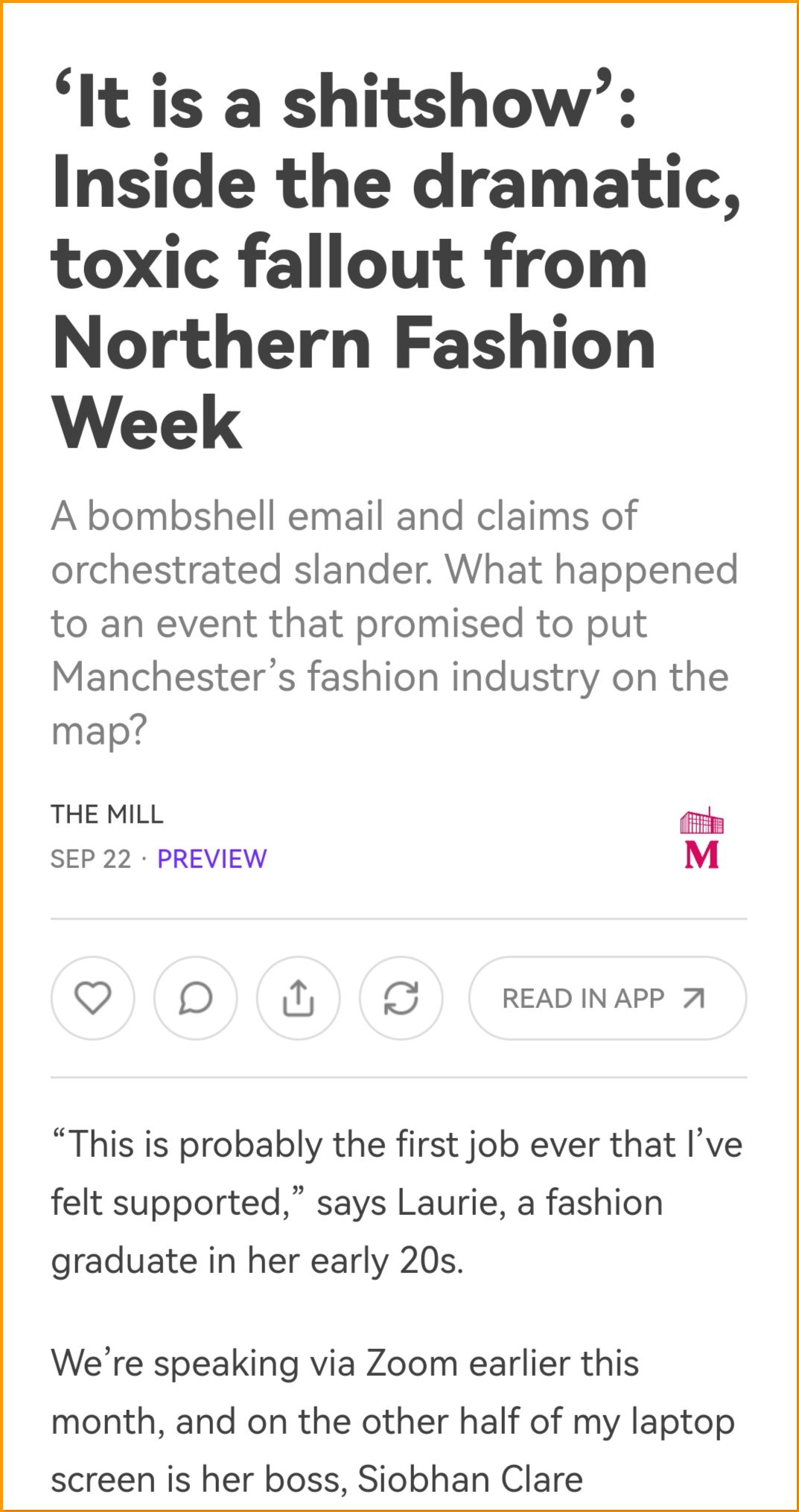CN#26. Is The Mill a model for the future of local journalism?

The Mill, a quality, broadsheet-style newsletter delivered by email in Manchester, is probably the most significant experiment in UK local news markets of the past few years.
The reader-funded publisher has achieved remarkable success, receiving praise for its journalism and achieving 40,000 free and 2,500 paid subscribers in 3 years.
Clones have been launched in Liverpool and Sheffield, and now private funding has been raised to expand into more cities.
So is this what success in local news looks like?
Is this approach sustainable and what are the limits to growth?
What are the hurdles for other organisations taking this route?
And finally, is this model the future of local journalism, and if so, why is no one else doing it?
NEWSLETTER DATA
FREQUENCY: Twice a week
TYPE: Consumer, news
PURPOSE: A mission to explain, reveal and hold power to account in Manchester
LAUNCHED: June 2020
SUBSCRIBERS: 40,000 free, 2,500 paid (6.25% free to paid conversion rate)
ESTIMATED ANNUAL REVENUE: £150,000 - £200,000
WORD COUNT: 3,000 to 4,000 words
SAMPLE SUBJECT LINES:
Over a quarter of Greater Manchester is used for farming. Should we understand it better?
Has Manchester Pride got its mojo back?
GMP [Greater Manchester Police] helped to jail an innocent man. But the chief constable won't answer questions.
DESIGN: Clean, plain text. No graphics, occasional photographs. The words do the work.
Is this the antidote to local news withdrawal symptoms?
When The Mill arrived in 2020 the professional classes of Greater Manchester, like those around the UK, were suffering from serious local news withdrawal symptoms.
This was due in no small part to the decline of the once-mighty Manchester Evening News, now a flimsy print offering with a website so unappetising that readers stay for an average of just 2 seconds.
So it was with some justification that The Mill founder Joshi Hermann declared his bedroom venture "the rebirth of high-quality local journalism", albeit on a small scale.
By avoiding the foot slog of covering daily crime, accidents, and court reporting, he could concentrate on differentiating with in-depth and investigative editorial on politics, injustice, culture, community, history and local people.
And the content chimed with a highbrow target audience, appreciative of a focus on quality rather than quantity, serious rather than trivial, and who couldn't find similar stories anywhere else.
The first few articles set the tone:
- A long form investigation into the disappearance of three teenagers from a private school in Manchester.
- A feature about the little-known life of James Watkins, a fugitive slave who came to Bolton and Manchester in the 1850s.
- A news story about arrests in Rochdale as part of a new grooming investigation - a Mill exclusive which was followed up by the BBC, ITV and several newspapers.
A recent issue about the poor business management of the Northern Fashion Show illustrated The Mill's knack for reporting real life issues (suppliers and employees not getting paid) in a storytelling style that takes the reader on the investigative journey.

In terms of serving local democracy by shining a light in places people don't want it shone, and digging deep into the community, The Mill absolutely delivers, and has proven the idea can be replicated.
It's perhaps too soon to know if this is making Manchester "better, more accountable, fairer and richer", as intended, but the journalistic mission has begun.
So what about the commercial side? Can The Mill develop into a sustainable business that makes money for shareholders?
Understanding the limits of a reader-funded business model
Brilliant journalism is, of course, just one important part of the jigsaw of a winning commercial news venture.
So far The Mill has punched above its weight in the difficult business of persuading people to get their credit cards out.
This is partly because the content is rare and valuable, but also because there is a sense of supporting a good cause, in the way that The Guardian gets a financial boost by way of donations.
Paid subscriptions are £7 a month or £70 a year and, as always, it might be worth testing a higher price point given the relative wealth and moral alignment of the audience.
The ratio (or conversion rate) of free to paid subscribers is a better than average 6.25%, a sure sign that readers like what they see.
"Super supporters" can choose how much to pay, with a suggested starting point of £120 a year. Maybe this could be higher, too.
Taking publicly available information into account it seems fair to estimate annual revenue for The Mill to be between £150,000 and £200,000.
At this level, and considering the lean editorial and marketing spend (many new subscribers are converted from the Substack recommendation engine, independent word of mouth recommendations, or relatively low cost Facebook ads), the newsletter could be sustainable.
But what are the prospects for organic growth into something more financially substantial, and how big could The Mill become?
What's the addressable market? It's part art and part science.
There are two big challenges to growth with a reader funded business model: the size of the addressable market and subscriber "churn" or fall-off rates.
A fantastic product, artfully crafted with unique selling points can create demand that didn't exist, and commentators have showered plaudits on The Mill for the quality of its output.
On the other hand, there are well documented constraints on the proportion of a population interested in long-form written news, or any written news, however good it is.
In the UK in 1950 total national newspaper readership was 11m out of a population of 50m, an addressable audience of 22%.
Let's just pause for a moment to reflect that even at what was arguably the post-war peak of popularity, just one in five people engaged with a newspaper.
In 2023 total national newspaper readership is 3m with a population of 67m, meaning that the addressable audience is now just 4.5%.
In other words just one in 20 people are interested in newspapers.
As we know, even that much reduced audience is fought over by tabloid and broadsheet style offerings.
Although these are national figures and not strictly applicable to a local news audience, and granted that some long-form readership has moved online, the audience size is still relatively small.
With Greater Manchester's population of around 1.2m, the addressable market for the free version of The Mill "might" be as small as 50,000, or at a push, 100,000.
Realistically, and even with a strong free to paid conversion rate, the ceiling on paying subscribers could be as low as 3,000, and perhaps only as high as 6,000.
That implies a maximum subscription revenue of £420,000 (assuming no price increase).
For organic growth it seems likely that The Mill would have to broaden its appeal, or popularise the coverage, perhaps with a more inclusive "lite" version.
The tight economics probably explains why big local news publishers Reach, National World and Newsquest havn't been falling over themselves to fund this kind of venture, unless someone else, like Google or Facebook, is paying.
The rewards probably aren't big enough to justify the investment.
The second growth hurdle The Mill will probably encounter, is that the bigger a subscription list grows, the harder it becomes to grow.
This is due to the drag effect of the cancellation or "churn" rate.
Some readers get bored, others stop seeing the value or have budgetary pressures, and with an ageing demographic, an inevitable proportion will no longer be with us each year.
This means that to continue to grow the list at a similar rate to the early "low hanging fruit" phase, the new subscriber acquisition rate has to be running ever faster.
Recurring subscription revenue is mostly reliable, but only available from a pretty tiny proportion of readers. Perhaps with this in mind, The Mill has abandoned any idea of being ad-free and started to take advertising.

As Brian Veseling of the news trade body WAN-IFRA deftly pointed out recently, The Mill has found early sustainability by "flipping scale on its head" or putting it more bluntly, by being small scale.
Growth through new launches
Diversifying revenue is a logical and necessary commercial move that many previously subscription-only newsletters now accept, even if it dilutes the editorial message, challenges independence and creates conflicts.
A sign of acceptance of the ceiling on growth for such a tightly defined editorial mission is The Mill's decision to grow by geographical expansion.
Taking advantage of a £100,000 Substack grant, it partnered to launch successful clones in Liverpool and Sheffield, and these businesses are exhibiting similar editorial success and subscriber profiles.
With 9 full-time staff members across the company as a whole, revenue for the parent company Mill Media (three newsletters) is expected to be £400,000 in 2023.
Following additional funding of £350,000 recently (valuing the business at £1.75m), the plan is to launch in further cities with Leeds, Birmingham, Glasgow and Newcastle the top candidates.
Hermann thinks the model will work in ten UK cities (not including London, which is well served) where there are big professional classes and multiple universities, although starting a presence in all of them will require more funding.
The boring business challenges ahead
The Mill has proven that high quality journalism can work in local markets on one level, but there are the usual business challenges ahead, particularly if it remains independent.
The new funding will in the short term cover the cost of new hires in the form of a commercial director, a senior editor and more writers.
The looming question is whether turnover can keep up with the expanded overhead, including the 10% revenue share to Substack that will become an increasingly large cash suck.
Other hurdles include the pressure to pay the founder and staff a market rate for their talent, and the question of whether subscriber cost of acquisition can be controlled.
Meanwhile the competition, currently dealing with a few problems including falling online advertising rates and striking journalists, appears to be waiting.
Reach is reportedly "fighting back" in Manchester with an email newsletter team backed by Google cash, and there is potential for national broadsheets to launch regional newsletter editions, drawing on their existing overhead.
Finally, it is worth acknowledging the importance of a visionary with the skills and commitment to make a venture like this work. Others might not succeed without someone similarly energetic.
Finding the right model for a "killer application"
Low cost, high value newsletters are a killer application that can restore a crucial public service to devastated local news markets.
They cut through issues of rising print and distribution costs, the fight for web clicks and eyeballs, and deliver a targeted, engaging, easy to consume product.
There are, thankfully, many models for running them, and the jury is out on which serves an audience best and which will be the most sustainable and profitable.
Building a narrowly-defined solution to local news decline, The Mill has embraced a subscription model, probably the best starting point.
This is already morphing into a hybrid to include advertising, and could conceivably encompass paid events and one-off print products.
In the US, publishers like 6AM City, City Cast and Community Impact among others have targeted a much broader community audience from the outset with an advertising driven newsletter model.
Most avoid the negativity of hard news but mix serious coverage of community issues with leisure, entertainment and lifestyle.
Those with the best chance of long term viability are likely to combine the two editorial approaches with a multiple revenue stream model.
The mystery remains why this approach hasn't been adopted in the UK.
